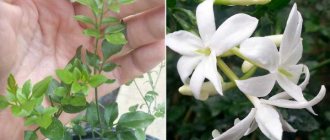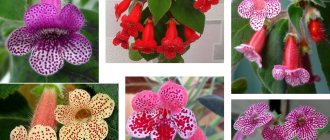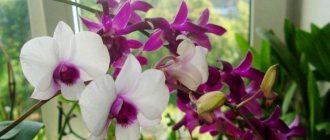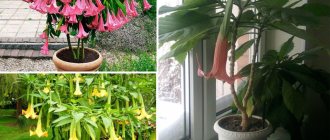Photo of the Schlumbergera flower (Decembrist) - one of the most popular indoor plants. Belongs to the cactus family. It is distinguished by drooping stems and well-growing branches .
There are teeth at the ends. The plant received its name in honor of the French cactus collector Frederic Schlumberger. Although sometimes the flower is also called the Decembrist. Schlumbergera is native to the southeastern region of Brazil.
Decembrist grows up to 40-50 cm in height. Several centimeters are added in one season. The plant lives for several years.
Flowering is one of the reasons for its popularity. Flowers appear at the ends of the shoots. Usually their size is about 2.5 cm. But sometimes large buds appear. Another distinctive feature is the brightness of the flowers.
Also pay attention to the beautiful plants Gymnocalycium and Jatropha.
| Low growth rate. 5-10 cm per year. |
| Blooms in autumn and winter. |
| The plant is easy to grow. |
| Perennial. |
Beneficial features
Schlumbergera.
Photo No beneficial properties of the flower were identified, nor any harmful ones. However, there is an opinion that the plant can still bring some benefits, with the exception of its beautiful appearance.
Flower growers believe that the Decembrist brings positive energy. Some note that in the house in which the plant appeared, the number of quarrels was reduced.
The flower itself also requires dedication from the owners. Schlumbergera loves when people talk to her and when she is praised for flowering.
It is also believed that the flower can ease allergic reactions and relieve insomnia.
Varieties
There are many types of Christmas cactus, which differ from each other in the structure of the flower and its color. If you wish, you can view many photos and videos showing different versions of these colors. This approach will help you decide which types you prefer: elegant liberty, evoking cheyenne, or something completely different.
We will look at the main types:
Schlumbergera truncatus has light green stems with jagged edges. Their length can reach 30 cm. The photo shows that the plant is decorated with single flowers at the ends of the segments, which have a curved shape and sharp leaves. The stamens look like light tufts extending far beyond the inflorescence. The color of Schlumbergera truncated can be different: from soft white to bright scarlet.
During the flowering period, Schlumbergera bucklei acquires long flowers with sharp, elongated petals. The color of flowers can vary very widely (from snow white to dark burgundy). The stems are fleshy and thick, have a dark green color. Also, it is worth mentioning such an interesting subspecies as Schlumberger liberty. As you can see in the photo and video, it has flowers of an interesting shape with a protruding oval edge and an unusual color. In this case, a mix of colors is observed - the color of the flower changes depending on the flowering period.
Schlumbergera russelliana differs from previous species in its widely branched stems, which can reach a length of up to 1 m. Flowering occurs in late spring - early summer. At this time, bright flowers with a greenish tube and a large number of pointed petals appear on the Christmas cactus. The color range mainly ranges from bright red to burgundy-purple, although there are also white options. Photos and videos wonderfully demonstrate the rich shades of the inflorescences.
Popular articles Rose Eddie Mitchell - description of the variety
Schlumbergera Gaertneri (gaertneri) is a very large cactus that has massive leaf segments and large bright flowers in all shades of red. It has a very impressive and memorable appearance, which is very noticeable in photos and videos.
Among varietal cacti, the buckley cheyenne cactus subspecies is gaining popularity, which is distinguished by beautiful flowers with many leaves and a delicate two-tone color.
Features of growing at home. Briefly
The main points for caring for Schlumbergera at home are presented in the table.
| Temperature | In summer, room temperature is required - approximately 27℃. In autumn you need a lower temperature - about 10℃. In winter, when flowering begins, an increased temperature will again be needed - about 20℃. |
| Air humidity | Spraying is required regularly, both in summer and winter, if the temperature exceeds 16℃. |
| Lighting | Bright, diffused lighting is needed, especially in winter. It should also be protected from direct exposure to sunlight. |
| Watering | In summer and during flowering, watering should be done frequently; in autumn, the frequency of watering should be reduced. |
| Priming | Requires soil with a lot of humus. It should also be well drained. |
| Feeding and fertilizer | Required during growth. Suitable fertilizer for cacti or flower plants. |
| Transfer | Required every 3 or 4 years. Carried out in early or mid-spring. |
| Reproduction | Propagation by cuttings is easy. |
| Features of cultivation | It is most convenient to grow in hanging baskets. |
Timing and optimal conditions of reproduction
Since several different methods are used to propagate Schlumbergera, it would be incorrect to talk about uniform rules regarding the most suitable timing for this.
Experts recommend cutting Decembrist immediately after pruning, since it is at this moment that it is easiest to obtain the planting material necessary for propagation without damaging the mother bush.
Traditionally, the succulent is pruned immediately after flowering, but if the plant does not bloom, this procedure is recommended to be carried out in late spring or early summer. In this case, the bush receives an additional incentive for development, and by Christmas you can count on the appearance of flowers.
Important! Experts say that Schlumbergera cuttings that are cut from the mother plant during the first month of spring take root best. At the same time, there is another opinion, according to which the ideal time for rooting cuttings is summer.
Like any inhabitant of the tropics, the Christmas tree is very demanding of humidity. And although an adult plant can adapt to the dry air of city apartments no worse than ordinary cacti, which are characterized by increased drought resistance, it can be quite difficult for a young Schlumbergere to develop in such conditions.
For this reason, when choosing a time for plant propagation, it is better to focus on the period when centralized heating in the house is either turned off or reduced to a minimum.
Christmas tree seeds are usually recommended to be sown in the spring. The same applies to grafting, although, as in the case of cuttings, flower growers are not unanimous on this issue: some cactus growers advise budding in mid-April, arguing that in this case the young plant can bloom next winter.
Caring for Schlumbergera at home. Details
Schlumbergera flowers rarely appear indoors. To increase the likelihood of flowering, you need to know the details of plant care.
Bloom
It is no coincidence that the Schlumbergera plant received the name Decembrist.
Its flowering occurs just in December. Some species bloom in February. Buds begin to appear in early December . At this time, you cannot disturb the plant - turn it, move it to other rooms. Such actions can lead to the buds falling off.
Also at this time it is necessary to maintain humidity and feed the flower. The room temperature during flowering should be about 20℃.
If the described conditions are provided, you can see bright flowers of different shades. The most common colors are red, white, pink, purple, orange.
Temperature
In winter, the room temperature should not be higher than 20℃. If the temperature is elevated, the plant will not wither, but the buds from which flowers develop may not appear. Another important condition for kidney development is short daylight hours.
Also, temperatures should not be too low. At a temperature of 3-5℃ the plant will die. In summer, the plant will be comfortable at a temperature of 15-20℃.
But the heat should not be constant, otherwise the Decembrist will not bloom at home.
Spraying
To ensure flowering, Schlumbergera must maintain high air humidity.
Spraying should be plentiful and constant, especially in summer. In winter, spraying must be done with caution to prevent frostbite of the flower. The water with which it will be sprayed must be warm. Lack of moisture will cause the buds to drop.
Lighting
A good solution for the location of the Decembrist would be to place it on the windowsills of the eastern and western sides. In these places it will have enough sun, and the likelihood of drying out will be significantly reduced.
to place the Schlumberger over radiators and heaters .
Watering
As for this point on caring for indoor Schlumbergera, the peculiarities of the plant’s origin are taken into account.
In summer and during flowering, regular and abundant watering is required .
The rest of the time it can be reduced to 1 time per week.
Pot
The root system of the plant is poorly developed, because under environmental conditions the flower begins its development near the roots of trees. This means that initially it does not require a large pot. A pot 10 cm high and 6 cm in diameter will be enough.
Priming
Based on the previous point, we can conclude that the Decembrist requires the most loose soil possible. You can prepare it yourself. This will require 1 part peat, 1 part sand and 1 part deciduous or turf soil.
You can make drainage at the bottom of the pot. It must conduct moisture well, because Schlumbergera does not like stagnant water.
Under no circumstances should Decembrist be planted in clay or loam. This soil does not conduct moisture well and limits air access. Other deviations from the described conditions are acceptable, but it must be taken into account that Schlumbergera may not bloom.
Feeding and fertilizer
The flower can also grow in poor soils. But to ensure its beautiful appearance, feeding is required. The plant should be fed no more than 2-3 times a year during flowering and growth.
When purchasing fertilizers, you should pay attention to the composition. If there is nitrogen in the composition, its content should be average. Excess of this substance will lead to rotting of the roots.
Schlumbergera transplant
It is best to transplant while the plant is growing.
When choosing a pot, you need to take into account the need to grow the root system in breadth, not in depth. Therefore, the new pot should be the same depth. The width of the new pot should exceed the width of the previous one by 2-3 cm.
The soil needs good drainage because the roots are more susceptible to rot when replanted.
Young plants are replanted every year, older plants - once every 2 years.
How to trim Schlumbergera
There is an important point regarding pruning Schlumbergera - it is not advisable to cut the plant. It is better to pluck the heavily overgrown parts. Plucking is important because it causes new shoots to appear and new buds to develop from them.
Rest period
This period begins immediately after the plant blooms. During the dormant period, your home Schlumbergera should be kept in a cool place. The desired temperature is 15℃. Decembrist rarely needs to be watered and sprayed. The main thing is to ensure that the soil does not dry out.
Is it possible to leave the plant without care during the holidays?
If you are planning a family vacation, it is advisable to have someone water the plant while the owners are away. It is especially dangerous to leave Schlumbergera without watering in the summer.
What does the plant look like and how does it bloom?
- The stem is jointed, dark green. It consists of flattened shoots (cladodes) of a teardrop shape. At the top of the cladode, from 2 to 5 shoots grow - thus, the prickly pear branches in the form of a bush.
- The leaves are rudimentary, succulent, awl-shaped, up to 1 cm long, appearing in the areoles of young cladodes. They are pressed to the surface of the shoots and die off over time.
- The root system is superficial, fibrous.
- The flowers are funnel-shaped, single, multi-petaled, wide-open, from 3 to 6 cm in diameter. Colored in yellow, orange, red, pink and white. The stamens react to touch and immediately curl. Buds are formed along the edges of the cladodes. The flowering period is from April to August. In different species - from a week to 4 months. Only adult plants bloom from 4-5 years of age.
- The fruits are fleshy, weighing from 70 to 200 g, 5-12 cm long. They ripen from the end of July. The pulp is juicy, tender, watery. The consistency and taste is similar to ripe, sweet gooseberries and kiwi. Ripe fruits have pink-orange, red, and purple skin.
- All types of prickly pear, in addition to spines, have bundles of glochidia, which are located in the axillary buds of the stem and on the fruits.
Propagation of Schlumbergera by cuttings
At first glance, it may seem that it is difficult to propagate Schlumbergera from cuttings. However, it is easier than it seems. To break off the stalk, you need to rotate it around its axis several times. Then the cuttings are dried and planted on moist soil. Their root system begins to develop quickly. At first the new plant will not show any signs of growth. But soon the buds will begin to appear.
There is also another interesting feature of the Decembrist. It can be propagated by grafting onto another plant. To do this, you need to cut off the top of another plant, make a cut on the stem and place a Decembrist cutting there. The junction is tied with thread. It can be removed after the plants grow together.
How to transplant Decembrist
Decembrist is replanted after flowering - at the end of February. The planting container is spacious and shallow. It is not necessary to replant it in a new pot every year, it all depends on the growth rate. In general, Decembrist grows quite slowly. And if, in your opinion, it has not gained too much in size, you can not replant it, but replace only the top layer of soil, which has become depleted and contains an increased amount of salts. To do this, loosen the soil in the pot with a wooden stick and remove 2-3 cm of soil with a spoon or scoop. Add fresh soil. Never take a pot for the Decembrist with a large margin in size - you will inevitably flood and destroy the plant.
Soil for Decembris
The soil for Decembrist should be light, porous, with a small humus content - richer than for other cacti. Decembrist does not like heavy clay soil and does not grow well in light sandy or poor peat soil. These soils are not structured for this cactus. It is better not to use ready-made soil from the store, without first checking the quality: good soil does not contain expanded clay, has a full list of components included in the soil mixture (leaf soil, peat, etc.), absorbs water well and quickly - after watering In 2-3 seconds, all the water goes into the soil (even if it is very dry).
Approximate soil composition for Decembrist (Schlumberger):
- 1 part turf soil, 2 parts leaf soil, 1 part fine gravel (or very coarse sand - 3-4 mm), plus a couple of teaspoons of brick chips per pot.
- 1 part turf soil, 2 parts leaf soil, 2 parts zeolite granules (from Barsik standard cat litter).
Good drainage is needed in any pot, even clay. You can use polystyrene foam or large expanded clay as drainage. Expanded clay does not need to be included in the soil composition. Before transplanting Schlumbergeras, be sure to sterilize the soil.
Popular articles How to get rid of resin on pine cones
Diseases and pests
The appearance of diseases in a plant indicates improper care. The following signs indicate an unsuitable environment:
- The buds and flowers of the Decembrist fall off - sudden temperature changes, drafts. Falling off can also happen due to the movement of the plant.
- Schlumbergera does not bloom - in the fall the plant was in conditions with temperatures below 10℃.
- Light spots on the plant indicate excess light.
- It grows slowly , which means it lacks nutrition.
- Wet, watery, or slippery spots indicate a viral or bacterial infection. Infected specimens are almost impossible to save.
- Root rotting indicates overwatering in autumn or winter, or excess fertilizer. In this case, it is better not only to reduce watering, but also to root the plant again.
Some people think that if Schlubmegera is not a very demanding plant, it means that it is not necessary to comply with all care conditions. This is the main mistake gardeners make.
Pests that may appear:
- spider mite;
- scale insect;
- mealybug.
The appearance of pests can lead to the death of the plant.
What difficulties may arise
Due to its weak root system and less dependence on soil than other plants, Schlumbergera is relatively rarely subject to the most common diseases and pest attacks of indoor flowers.
However, such problems are still possible, especially if suitable conditions are not created for the zygocactus.
Did you know? The world's largest cactus is the giant cereus, also known as the California giant. Its weight can reach 10 tons, and its height can be 25 m. At the same time, the miracle succulent begins to actively grow in the 30th year of its life, and blooms not earlier than at the age of half a century.
Among the difficulties faced by Christmas tree owners are the following:
- Pest infestation. Serious harm to zygocactus can be caused by scale insects, whiteflies, mealybugs, spider mites, and aphids. When the first signs of damage are detected, the plant should be treated with a soap or alcohol solution. Among the effective folk remedies, one can also mention garlic or onion infusion, decoction of horsetail, wormwood, etc. If the problem cannot be solved in this way, chemicals are used - insecticides or acaricides.
- Fungal infections, in particular late blight and fusarium. The cause of the disease in the vast majority of cases is high humidity or stagnation of water in the soil. Since it is quite difficult to fight the disease, it is better to prevent it by providing the zygocactus with reliable drainage, proper watering regime and a suitable microclimate. If the plant withers, becomes faded, and characteristic areas of fungal infection appear on the stems, it is necessary to treat the flower with a systemic fungicide, and in some cases, replant it, completely replacing the soil with fresh one.
- Lack of flowering. This process can be stimulated by creating a pronounced dormant period for the flower, accompanied by a decrease in temperature, limiting watering and stopping feeding. If the zygocactus does not bloom even after such an event, this means that the plant is not suitable for general conditions - humidity, temperature, watering, lighting, ventilation, soil composition, pot size, etc.
- Falling leaves. In this way, Schlumbergera also reacts to the grower’s mistakes, but in this case we can say that the flower is in conditions close to critical. It is urgent to analyze the causes of the problem in order to take measures to eliminate them. The only caveat: dropping leaves and flowers may be a reaction to a sudden change in living conditions. For example, this can happen soon after transplanting a zygocactus, moving it to a new place, turning on (off) central heating, etc. In this case, there is no need to panic - after a while the flower will adapt and restore the loss of green mass.
Reproduction of Schlumbergera is a creative and very exciting process.
Even a novice cactus lover can get a young plant by rooting cuttings, but more experienced gardeners can try their hand at mastering such non-standard methods of growing new specimens of the Decembrist, such as grafting a less demanding succulent onto a standard or even breeding a new hybrid through artificial pollination and subsequent collection seeds for planting.
Types of Schlumbergera domestica with photos and names
Schlumbergera truncates
The stems of this species diverge from the middle and hang beautifully in different directions. The shoots can reach 40 cm. The segments have sharp teeth on the sides. Schlumbergera truncata flowers come in a wide variety of shades.
There are also several varieties of this species
Bridgeport
This plant is distinguished by its flowers, or rather their color. Plants of this variety are called snow-white Schlumbergera. Most often, the flowers are white and round in shape. Sometimes pinkish flowers are also found.
Cambridge
This variety differs in the color and shape of the flower. At the beginning of flowering, you can see peach buds and blooming flowers. But over time they will turn yellow.
Christmas Charm
The red purple color indicates that it is a Christmas Charm plant. This color is the most common. However, different shades of pink can also be found. This variety of Schlumbergera grows quickly, making it perfect for a hanging pot.
Kris Kringle
The plant also produces bright red flowers. The variety is also distinguished by short segments and compactness.
Lavender doll
This variety, on the contrary, is characterized by long segments. The flowers are large, lavender in color. To get a vertical bush, the plant must be pinched every year.
Peach Parfait
The plant is characterized by vertical growth. Therefore, it is better to place it in a regular pot rather than in a hanging one.
Santa Cruz
This variety is characterized by bright red-orange flowers. It also differs in that the buds begin to take on bright colors early.
Twilight Tangerine
The plant is notable for its light orange or light pink flowers and wide stems.
Schlumberger at a Glance
- Botanical name: Schlumbergera (lat. Schlumbergera);
- Other names: Decembrist, Rozhdestvennik, zygocactus, Decembrina, Christmas cactus;
- Family: Cactus (lat. Cactaceae);
- There are many species of the genus Schlumbergera;
- Original origin: Brazil;
- Height: 45 cm;
- Height width: 30 cm;
- Shrub with strongly branching shoots;
- Leaf links are up to 5 cm long;
- Flowering period: from November to December;
- Flower color: white, pink, light purple, red, orange (depending on the variety).
What kind of pot does a zygocactus need?
The root system of the Decembrist is superficial, that is, it grows in breadth and not in depth.
The Christmas pot is not deep, but wide. However, a container that is too large is also not the best option, since the plant will strive to fill the entire container with roots, devoting all its energy to growing them. In this case, you can forget about Schlumbergera flowering. The size of the pot should be slightly larger than the previous one (10%).
As for the material from which the pot is made, both plastic and clay containers are equally suitable. Plastic is a substance that does not absorb water and does not change the temperature of the soil in the pot. Clay and ceramics are environmentally friendly products. The choice in this matter remains with the florist. But it is better if the pot is light in color so that the soil in it heats up less.
Description and characteristics
Decembrist cannot be confused with any other plant.
Graceful, evergreen shoots are flat in shape, with jagged edges. And on them are lovely flowers, reminiscent of bells, only multi-tiered and more elegant. Initially, zygocactus produced only red buds.
However, over time, breeders developed new colors: white, pink, yellow, orange, lavender. The height of the Schlumbergera cactus reaches 30-40 cm. The stems of the Decembrist are arched, straight or branched.
Some interesting facts about Schlumberger:
- In nature, this flower is pollinated by the smallest birds on the planet - hummingbirds.
- In the tropics, Decembrists grow on trees, but do not parasitize them. Hence the strong roots and rapid growth.
- This is a long-lived flower that, under good conditions, can live up to 25 years.
- It is not considered a capricious plant, but when flowering it is better not to rearrange it or rotate the pot. May drop buds.
- In order for the Decembrist to bloom more often and more luxuriantly, you need to periodically pinch the shoots.
Genus name.
When different botanists discovered this cactus in nature, they gave it their name. Therefore, it was known, for example, as Epiphyllanthus (lat. Epiphyllanthus A.Berger), Epiphyllum (lat. Epiphyllum Pfeiff.), Opuntiopsis (lat. Opuntiopsis Knebel). In our country, for a long time it was generally accepted to call it zygocactus (lat. Zygocactus K.Schum.). All of the above names are used as synonyms. In modern taxonomy, it is believed that the earliest name has precedence. Therefore, it is correct to call this cactus after the French collector of succulents - F. Schlumberger. The name was given by botanist Charles Lemaire in 1858. Carl Schumann (who named it Zygocactus) described the genus a little later - in 1890.
Signs and superstitions
Any housewife sighs with relief when the Decembrist blooms in a timely manner.
This is due to a sign. According to her, if a flower blooms in December, then the year will be good. Prosperity and mutual understanding will come to the family, and adversity and sorrow will go away. There are also signs about the Decembrist :
- the more buds, the stronger the frost;
- if the flower began to hurt for no reason, there was a person in the house who wished you harm;
- the Decembrist does not bloom, which means there are quarrels in the family;
- The annual flowering of the Christmas tree promises financial well-being.
Of course, the Decembrist is the most charming cactus that exists today. While other flowers are in winter dormancy, it will delight all household members with beautiful flowers. Easy to care for and beautiful to look at, it will be a pleasant gift for any gardener.
Vaccination
The method is very popular, since if you place its spreading crown on the trunk of another deciduous cactus (for example, pereskia or pereskiopsis), you get a standard tree that looks very impressive in the interior.
The grafting process is very painstaking and has a number of features.
- A segment is selected on one of the Schlumbergera branches, which will become the grafting material.
In the place where it grows from the previous segment, you need to cut off the sides with a sharp knife, giving the segment the appearance of a triangle, the acute angle of which is directed towards the previous segment. Leave the Decembrist for several days. During this time, the wounds will heal, and the damaged segment will get used to existing in conditions of limited nutrition, when communication between it and the rest of the Schlumbergera is difficult. Attention! Sections must be treated with crushed coal or sulfur powder, because Zygocactus wounds can become infected. - The trunk of the rootstock plant is cut off, and the cutting site is split to a depth of 1-2 cm. All tools must be disinfected.
- Pinch off the prepared Decembrist segment with your hands and insert the rootstock plant into the split.
- For fixation, use a needle, thread or thorn if it is used as a rootstock.
- The grafting site should be treated with charcoal or sulfur powder and a bag should be placed over the grafted segment to prevent drying out.
Schlumbergera may wilt and wrinkle in the first days after vaccination. But, if the operation was successful, then soon the plant comes to life and begins to grow new segments. This takes approximately 2-3 weeks.











